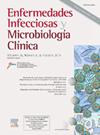加泰罗尼亚72家成人和儿科医院的抗菌药物消费趋势。2008-2022年VINCat项目结果
IF 2.6
4区 医学
Q3 INFECTIOUS DISEASES
Enfermedades infecciosas y microbiologia clinica
Pub Date : 2025-01-13
DOI:10.1016/j.eimc.2024.07.011
引用次数: 0
摘要
抗菌药物管理规划(asp)监测抗菌药物的使用并实施干预措施以改善其使用。在这里,我们分析了在西班牙加泰罗尼亚参加VINCat计划的医院在15年期间的抗菌药物消费趋势。方法我们对72个急症护理中心的成人和儿童人群进行了系统抗菌药物使用的时间序列分析。每年测量全身抗生素和抗真菌药物的使用情况,成人使用规定的每日剂量(DDD),儿童使用规定的治疗天数(DOT)。为了分析抗菌药物使用的趋势,我们考虑了以每100患者日DDD或DOT定义的年消费量。结果2008-2022年成人抗菌药物、抗生素和抗真菌药物的平均消费量分别为73.54、70.08和3.46 DDD/100患者-d。总体抗菌水平显著升高(rho = 0.554;P = 0.035),抗真菌药物也存在差异(rho = 0.657;P = 0.01)。抗生素消费量在第一阶段呈上升趋势,随后几年保持不变(rho = 0.482;p = 0.071)。使用最多的是青霉素类(33.5%),其次是头孢菌素(18.2%)、喹诺酮类(13.9%)、其他全体性抗菌药物(10.8%)和抗真菌药物(4.7%)。对2020年至2022年期间的儿科消费进行了分析。总体而言,该人群的抗菌药物、抗生素和抗真菌药物的平均使用量分别为60.04、53.47和6.57 DOT/100患者日。与成人一样,儿童是使用青霉素最多的家庭(34.3%);在该组中,青霉素联合β -内酰胺酶抑制剂使用最多(21.1%),其次是头孢菌素(19.3%)。结论在成人医院和儿科医院,VINCat项目的参与率都很高。15年的趋势表明,成年人抗菌药物的总体消费量显著增加。本文章由计算机程序翻译,如有差异,请以英文原文为准。
Trends in antimicrobial consumption at 72 adult and pediatric hospitals in Catalonia. Results of the VINCat Program 2008–2022
Introduction
Antimicrobial stewardship programs (ASPs) monitor antimicrobial consumption and implement interventions in order to improve their use. Here, we analyze the trends in antimicrobial consumption at hospitals participating in the VINCat Program over a 15-year period in Catalonia, Spain.
Methods
We conducted a time-series analysis of systemic antimicrobial consumption in both adult and pediatric populations across 72 acute care centers. The annual measurement of systemic antibiotic and antifungal use was conducted using defined daily dose (DDD) in adults and days of therapy (DOT) in children. To analyze trends in antimicrobial use, we considered the annual consumption defined in DDD or DOT per 100 patient-days.
Results
Overall adult consumption (2008–2022) of antimicrobials, antibiotics, and antifungals averaged 73.54, 70.08, and 3.46 DDD/100 patient-days respectively. There was a significant increase in overall antimicrobial (rho = 0.554; p = 0.035) and also in antifungal (rho = 0.657; p = 0.01) consumption during the study period. Antibiotic consumption showed an upward trend in the first period followed by an unchanged consumption in the following years (rho = 0.482; p = 0.071). Penicillins were the most frequently used (33.5%), followed by cephalosporins (18.2%), quinolones (13.9%), and other systemic antibacterials (10.8%) and antifungals (4.7%). Pediatric consumption was analyzed between 2020 and 2022. Overall, antimicrobial, antibiotic, and antifungal use in this population averaged 60.04, 53.47, and 6.57 DOT/100 patient-days respectively. As in adults, in children penicillins were the most used family (34.3%); within this group, penicillin combinations with beta-lactamase inhibitors (21.1%) were the most used, followed by cephalosporins (19.3%).
Conclusions
Participation on the VINCat Program was high at both adult and pediatric hospitals. Fifteen-year trends showed a significant increase in overall antimicrobial consumption in adults.
求助全文
通过发布文献求助,成功后即可免费获取论文全文。
去求助
来源期刊
CiteScore
2.10
自引率
8.00%
发文量
194
审稿时长
29 days
期刊介绍:
Hoy está universalmente reconocida la renovada y creciente importancia de la patología infecciosa: aparición de nuevos agentes patógenos, de cepas resistentes, de procesos con expresión clínica hasta ahora desconocida, de cuadros de una gran complejidad. Paralelamente, la Microbiología y la Infectología Clínicas han experimentado un gran desarrollo como respuesta al reto planteado por la actual patología infecciosa. Enfermedades Infecciosas y Microbiología Clínica es la Publicación Oficial de la Sociedad Española SEIMC. Cumple con la garantía científica de esta Sociedad, la doble función de difundir trabajos de investigación, tanto clínicos como microbiológicos, referidos a la patología infecciosa, y contribuye a la formación continuada de los interesados en aquella patología mediante artículos orientados a ese fin y elaborados por autores de la mayor calificación invitados por la revista.

 求助内容:
求助内容: 应助结果提醒方式:
应助结果提醒方式:


